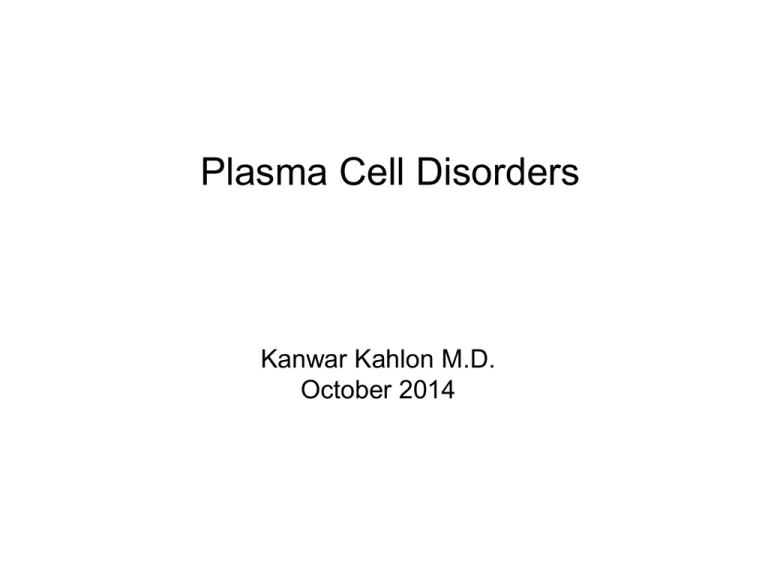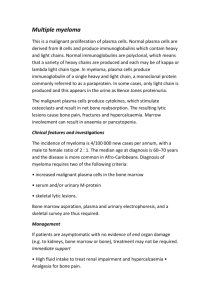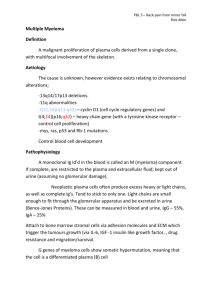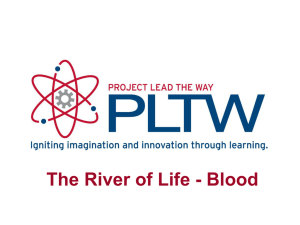Plasma Cell Disorders Kanwar Kahlon M.D. October 2014
advertisement

Plasma Cell Disorders Kanwar Kahlon M.D. October 2014 Subtypes of Plasma Cell Disorders • Increased Plasma Cells – Monoclonal Gammopathy – Myeloma – Macroglobulinemia (IgM) • Increased / Altered Products of Plasma Cells – Light Chain Amyloidosis – Light Chain Deposition Disease B cell Development As a Framework for Malignancies Lymphoplasmacyte IgM Lymph node Germinal Center SOMATIC HYPERMUTATION Plasmablast SWITCH RECOMBINATION Bone Marrow Lymphoblast Virgin B cell G,A,E Plasma cell V(D)J RECOMBINATION Pre-B cell B cell Development As a Framework for Malignancies Lymphoplasmacyte IgM WALDENSTROM’S Lymph node Germinal Center SOMATIC HYPERMUTATION Plasmablast FOLLICULAR LYMPHOMA Lymphoblast BURKITT’S LYMPHOMA Virgin B cell CLL Bone Marrow MULTIPLE MYELOMA G,A,E Plasma cell ALL Pre-B cell Case Presentation • 48 yo Jamaican male • Admitted with 2 wk history of fatigue and diffuse bone pain • Evaluation: – Increased serum creatinine 5.5 mg/dl (normal < 1.2 mg/dl) – Increased serum calcium 12 mg/dl (normal < 10.5 mg/dl) – Increased serum globulin 5.0 g/dl (normal < 3 g/dl) Evaluation of Abnormal Serum Globulins Serum Urine Serum/Urine Protein Immunofixation Electrophoresis (S/UPEP) Electrophoresis (IFE) Serum M spike 4 g/dl; typed as IgG kappa monoclonal Ig Case Presentation…cont’d Bone Marrow biopsy- Increased plasma cells Skeletal survey—Lytic bone disease Clinical spectrum of clonal expansions of transformed plasma cells in patients • Stable intramedullary expansion •Asymptomatic. MGUS (premalignant) Normal cell Transformed Cell • Progressive intramedullary expansion. • Anemia, bone pain, infections • Lytic bone disease. • Incurable, limited survival. Multiple myeloma (malignant) •13000 deaths/yr in USA. Diagnostic Criteria in Monoclonal Gammopathies • MGUS – < 10% bone marrow plasma cells and M spike < 3 g/dl – Monoclonal protein / clonal plasma cell population – No End organ damage • Myeloma – > 10% marrow plasma cells – End Organ Damage • Indolent / Smoldering Myeloma – > 10% marrow plasma cells or M spike > 3 g/dl – No End organ damage Criteria for End-Organ Damage in Monoclonal Gammopathies • CRAB – Calcium > 1 mg/dl above ULN – Renal Insufficiency (> 2 mg/dl) – Anemia (< 10 g/dl) – Bone Lesions (lytic lesions or osteopenia) A Model for Pathogenesis of Myeloma Monoclonal Gammopathy of Undetermined Significance (MGUS) • Common, age-related • Prevalence: 3.2% in persons over 50 yrs old (Minnesota) – ~5% in age >70 • Higher prevalence in African populations. • ? Association with inflammatory states: obesity, Gaucher’s disease • Increased risk for thrombosis and fractures • Risk of progression in entire population: 1% /yr • Risk factors for progression: %PC, level M spike, Free light chain, IgA protein, ?Decline in uninvolved Ig’s Smoldering Myeloma (SMM) • Patients with PC > 10% or M spike > 3 g/dl, but lacking CRAB symptoms. • 10% per yr progression to overt MM • Most eventually require therapy. • Current recommendation is observation until progressive disease. Disease Progression in MGUS and SMM Kyle et al. NEJM 356: 2582, 2007 Risk Groups in Asymptomatic Myeloma G1: BMPC >10% M > 3 g/dl; G2: BMPC >10% M < 3 g/dl G3: BMPC <10% M > 3 g/dl Kyle et al. NEJM 356: 2582, 2007 Multiple myeloma • • • • • Uncontrolled proliferation of Ig secreting plasma cells – most commonly IgG (57%), IgA (21%) or light chain only (18%) Twice as frequent in men as women, and in blacks as whites 1% of all cancers – 2% in African Americans Incurable Median survival 4-6 years 5 year survival (SEER) Work-up in suspected myeloma • Assessment of serum/urine protein – SPEP/IF, 24 hr urine for UPEP/IF – Free light chains (kappa, lambda) • CBC, sCr, Calcium, Albumin, LDH, • Serum beta 2 microglobulin (B2M) • Skeletal survey • Bone marrow aspirate and biopsy – Cytogenetics (including FISH) • Under investigation: – MRI spine – PET scans – Bone densitometry, Urine n-telopeptide * Kappa and Lambda FLC’s are both increased in renal failure/CKD Key clinical aspects of myeloma • • • • • • Predominantly intra-medullary growth. Absence of clinical LN or spleen involvement. Low proliferative fraction. Long periods of stability in MGUS. Osteoclast activation, osteoblast inhibition, and bone loss. Multi-focal growth of tumor cells. Clinical presentation Manifestations of Clonal Plasma Cell Proliferation Osteoclast Osteoblast LYTIC BONE DZ HYPERCALCEMIA Erythropoiesis ANEMIA Ig deposition Cast nephropathy RENAL FAILURE Immune-paresis Hypogamm INFECTION Historical aside… At age 39, developed fatigue and bone pain from several fractures. She died 4 years later; autopsy showed that her marrow was replaced by a red, gelatinous substance Multiple Myeloma: Skeletal Complications Original Article Romosozumab in Postmenopausal Women with Low Bone Mineral Density Michael R. McClung, M.D., Andreas Grauer, M.D., Steven Boonen, M.D., Ph.D., Michael A. Bolognese, M.D., Jacques P. Brown, M.D., Adolfo Diez-Perez, M.D., Ph.D., Bente L. Langdahl, Ph.D., D.M.Sc., Jean-Yves Reginster, M.D., Ph.D., Jose R. Zanchetta, M.D., Scott M. Wasserman, M.D., Leonid Katz, M.D., Judy Maddox, D.O., Yu-Ching Yang, Ph.D., Cesar Libanati, M.D., and Henry G. Bone, M.D. N Engl J Med Volume 370(5):412-420 January 30, 2014 Renal Pathology in MM Light Chain Deposition Disease Light Chain Cast Nephropathy AL Amyloid International Staging System • Stage I (B2M <3.5 mg/l; Albumin >3.5 g/dl) – Median OS 62 months • Stage III (B2M >5.5 mg/l) – Median OS 29 months • Stage II (Neither Stage I or III) – Median OS 44 months Principles Of Treatment • No evidence (yet) that early treatment prolongs survival • Wait for symptoms, or evidence of disease progression, to start treatment • Supportive measures are critically important – drink plenty of fluids daily – treat infections promptly – prophylactic bisphosphonates reduce skeletal complications in patients with osteopenia and lytic bone disease – anemia often responds to erythropoietin. “Myeloma treatment is a marathon, not a sprint” JCO, 30(4), Feb 2012 Major drugs in myeloma • Alkylators - 1962 – Melphalan, cyclophosphamide – High dose melphalan and ASCT • Glucocorticoids - 1966 – Prednisone, dexamethasone • IMiDs - 1999 – Thalidomide – Revlimid – Pomalidomide • Proteasome Inhibitors - 2001 – Bortezomib – Carfilzomib Treatment course Asymptomatic Symptomatic MGUS Stable MM Acute Pancytopenia Plasma cell leukemia M protein Treatments Years Months Days Cytogenetic Profiles of Myeloma Carrasco et al Cancer Cell, Sawyer et al CGG, 2011 IMWG Molecular Classification of Myeloma Hyperdiploid Percentage of patients 45 Clinical and laboratory features More favorable, IgG-κ, older patients. Non-hyperdiploid 40 Cyclin D translocation t(11;14)(q13;q32) 18 t(6;14q)(p21;32) t(12;14)(p13;q32) MMSET translocation t(4;14)(p16;q32) 2 <1 15 MAF translocation t(14;16)(q32;q23) 8 5 Upregulation of MMSET; upregulation of FGFR3 in 75% unfavorable prognosis with conventional therapy; bone lesions less frequent Aggressive Confirmed as aggressive by at least two series t(14;20)(q32;q11) 2 One series shows more aggressive disease. t(8;14)(q24;q32) 1 Unknown effect on outcome but presumed aggressive. Unclassified (other) 15 Various subtypes and some with overlap 16 15 Aggressive, IgA-λ, younger individuals Upregulation of CCND1; favorable prognosis; bone lesions. Two subtypes by GEP; CD20+ in one subset Probably same as CCND1 Rare IMWG. Leukemia 2010 Factors Associated with Increased Disease Risk in MM • Gene expression profile (GEP) 70 (or GEP15) high risk signature • FISH: – t(4:14); t(14:16) – Del 17p – 1q amp; hypodiploidy • Abnormal cytogenetics by metaphase, including del chr 13 • ISS Stage 3 (increased beta 2 m) • High LDH • > 10 focal lesions on MR Mayo Clin Proc, Apr 2013 Initial therapy in myeloma • Current approach based on risk status and potential candidacy for stem cell transplantation. • Combination therapy superior to single agents. High Response Rates to Induction Therapies in MM High dose therapy in myeloma • Small randomized trials showing superiority to conventional therapy without ASCT (two with mature data). • Early ASCT not superior to late ASCT. • No conditioning regimen superior to melphalan alone. • No benefit from CD34+ selected grafts. • Superiority of SCT is being tested in the setting of new drugs. Initial Therapy: Transplant Ineligible • Melphalan + Prednisone was once the standard approach. • RCTs show superiority of addition of thalidomide (MPT) or Velcade (MPV) to MP. • Lenalidomide and dexamethasone is also active. The future… JCO, 30(4), Feb 2012 Waldenström Macroglobulinemia • • • • • • Uncontrolled proliferation of lymphoplasmacytes producing IgM Median age 63 years Presents with weakness, fatigue, epistaxis, blurred vision Bone pain and lytic bone lesions are uncommon (<5%) 25% have hepatomegaly, splenomegaly and lymphadenopathy Hyperviscosity is common Mayo Clin Proc, Sept 2010 Hyperviscosity syndrome • • • • • • bleeding (nasal and gums) blurred vision dizziness, headaches, ataxia congestive heart failure retinal vein engorgement, and papilledema rarely occurs with serum viscosity <4 centipoises (cp) (normal 1.8 cp) IgM pentamer Macroglobulinemia: Principles of Therapy • Observation in patients with asymptomatic disease. • Active drugs for therapy – Alkylating agents: Chlorambucil, Cytoxan – MAbs: Rituxan – Purine analogues: Fludarabine, Cladribine – Bendamustine – Steroids – Bortezomib – Thalidomide analogues Plasma Cell Disorders Manifest Due to Clonal Immunoglobulin AL Amyloid Light chain deposition dz Neuropathy Cryoglobulinemia Acquired vWD Clinical Settings Where Ig Deposition Diseases (Including AL Amyloid) Should Be Suspected In Pts With Monoclonal Ig • • • • • • • • Congestive Heart Failure Neuropathy (including autonomic neuropathy) Nephrotic syndrome, Renal Failure Malabsorption Hepatosplenomegaly Carpal tunnel syndrome Macroglossia Unexplained constitutional symptoms Diagnostic Approach in Suspected AL Amyloid Principles of Management in AL Amyloid • Therapeutic approach guided by age, organ involvement. • Cardiac involvement and dysfunction as a major predictor. • Therapy directed at the underlying clonal plasma cells. – – – – Melphalan Steroids Proteasome Inhibitors (Velcade) Thalidomide/lenalidomide Conclusion • Plasma cell dyscrasias are a heterogeneous group of disorders. • Clinical presentation may be due to the clone itself or the properties of the secreted Ig. • Therapy largely directed (if indicated) at reducing the underlying clone.







